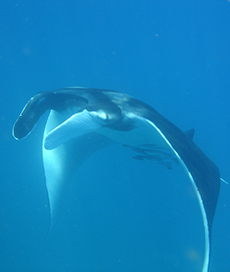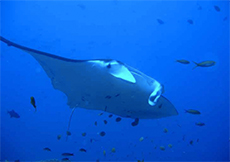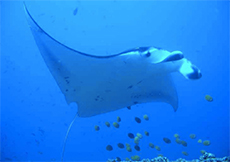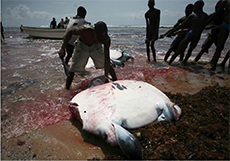




| Home | Features | Club Nights | Underwater Pics | Feedback | Non-Celebrity Diver | Events | 8 August 2025 |
| Blog | Archive | Medical FAQs | Competitions | Travel Offers | The Crew | Contact Us | MDC | LDC |

|

|
 
 |
     ISSUE 17 ARCHIVE - MANTAS IN FOCUSDr Simon PierceEverything we know and a few things we don'tMost divers will have seen, or at least heard of manta rays. They’re huge, charismatic, and the very possibility of their presence makes for an exciting dive. You’d be forgiven, then, for thinking that scientists are equally familiar with their lives. In fact, we’re rather in the dark. We know that there are eleven species in the family (counting both manta rays and their smaller relatives, the mobula rays)... except manta rays were only split into two species in 2009, and there’s probably a third one in the Atlantic. There are nine species of mobula rays, but only a few people in the world can actually distinguish them - and even they have their doubts. The pressing concern is that this small group of poorly-known rays are now amongst the most threatened fishes on the planet. With this in mind, Lydie Couturier - a PhD student from Project MANTA at The University of Queensland - recently brought together a group of her colleagues, including myself, to wrap our heads around the knowns and known unknowns of the manta ray world. That turned out to be a big job, but an interesting one. The Manta Ray Family TreeManta and mobula rays share a fairly similar body plan, which is mostly arranged around their dietary predilections. Two of their more notable features are the cephalic fins on either side of the head, which are used to funnel plankton-rich water into their mouths while feeding. These fins, which could look a bit like horns if you screwed up your eyes a bit, gave them the common name of ‘devil rays’, although you wouldn’t know it from the way they behave. Some animals have tough-as-nails common names - killer whales, hellbenders and woodchucks spring to mind - but devil rays don’t live up to their moniker at all, threatening only zooplankton and the occasional small fish. The fossil record suggests that devil rays have been around in their modern form for at least 20-25 million years. Unsurprisingly, they’re well adapted to their chosen lifestyle. They originally evolved from stingrays, and a ‘sting’ is still present at the base of the tail in some mobula species. True manta rays first appeared in the fossil record approximately 4.8 million years ago, amongst the most recent of all sharks and rays. Although reef manta rays (Manta alfredi) have completely lost their sting, giant manta rays (M. birostris) still have a spine encased within hardened cartilage in a visible bump at the base of their tail. Recent genetic work by Tom Kashiwagi (Project MANTA) and co-authors estimated that the two contemporary manta ray species split approximately 300 thousand years ago - a blink of the eye in evolutionary terms. This occurred during relatively recent glacial cycles, when there were major changes in ocean circulation, not to mention geography. To give you some idea of just what these changes represented, at that stage Britain was part of continental Europe and hyenas, rhinoceros and elephants roamed the countryside. This global restructuring promoted opportunities for diversification within wide-ranging species. Here, it appears that ancestral reef manta rays may have preferred to remain close to the coasts of these ancient seas, while giant manta rays became more oceanic. Just Keep SwimmingIf that was the case, the differences have persisted. The enigmatic giant manta rays appear in rather far-flung places such as southern Brazil and northern New Zealand each year, implying that significant ocean crossings are no barrier to these huge rays. Giant manta rays reach up to around 7 metres in width, somewhat larger than reef manta rays (hence the name). This size increase is likely to be related to the improved swimming efficiency that larger size confers - it may be worth noting here that Michael Phelps is 6’4 and Missy Franklin is 6’1! This behavioural difference probably explains why only giant mantas are found in the Eastern Pacific, whereas reef manta rays stop at Hawaii and French Polynesia. This is not to say that reef manta rays, which grow to around 5 metres width, are inadequate in the swimming department. Tagging studies in Mozambique have shown that individuals can move 70 km in a single day during normal activities, and they migrate at least 500 km along the eastern Australian coast each year. Although we presume they’re good island-hoppers, some reef manta populations appear to be rather isolated, such as Yap in Micronesia. Manta rays living around Maui and Hawai’i in the Hawaiian islands don’t seem to mingle across the 49 km gap between them at all, presumably becoming experts on where to find food locally instead. Spot the DifferenceSo, just how many manta rays are there? This simple question is proving tough to answer. Most mobula species are difficult to study underwater, as individuals are very similar to one another in colouration. Manta rays, however, are a different crate of fish entirely. It’s easy to identify each manta ray by the distinct spots and blotches on their stomach, and both species (helpfully) tend to come together in defined locations to feed or clean. This allows each manta to be photo- identified, which can then be used to generate estimates of population size. At the moment, the largest documented population of manta rays is in the Maldivian islands, where over 2,400 individuals have been photo-identified. This process will be immeasurably aided by the advent of the new global manta ray database at www.MantaMatcher. org, which is being powered by a manta-matching algorithm developed specifically for the task by scientists at the University of Cambridge. Mantas in Mensa?Manta (and mobula) rays have the largest brains of all the approximately 32,000 species of fish known to date. On first glance, this seems rather odd... how smart do you need to be to outwit plankton? We’re assuming that there are other explanations. In general, it appears that animals - especially primates - don’t become more intelligent to catch prey, but rather to outsmart one another. Recent studies have even shown that monkeys placed in larger groups increase their brain size to compensate. Could manta rays be the Einsteins of the fish world? They certainly display some behaviours that could suggest this, such as coordinated and cooperative feeding behaviours. We’re also becoming aware that giant manta rays, in particular, are truly deep-divers. And it’s cold down there. To keep these large brains warm, and possibly the rest of the body too (as in at least one of the mobula rays), these rays have an amazing counter-current heat exchange system going on with their veins and arteries to become effectively warm-blooded, or at least keep their temperature more stable than most fish. In Troubled WatersSadly, manta rays face a very uncertain future. The global catch of manta and mobula rays has dramatically increased over the last decade due to demand for their gill rakers from China, where they are sold as medicinal products. Catches from the major existing fisheries are not even close to sustainable. The fact is, few species are as vulnerable to over- fishing as manta rays. We know that they have a very slow reproductive rate, producing only one large baby on average every 1-3 years. They also appear to be slow-growing and long-lived, with a few wild manta rays being re-sighted over 30-year periods. In some areas, over 1,000 manta rays have been caught in a single year. Considering that the very largest scientifically-studied manta ray populations - in the Maldives and Mozambique - number in the high hundreds to low thousands of individuals, it is clear that these fisheries threaten the long-term survival of these species. Manta rays: almost 5 million years in the making, only 10 years to be pushed close to extinction. It’s not a happy story, but there is hope. Giant manta rays were added to the Convention on Migratory Species in 2011, which is sparking coordinated national efforts toward protection of the species and their key habitats within member countries. Next year, the entire group is up for listing on the Convention on International Trade in Endangered Species. If successful, a listing on CITES would be an acknowledgment that the gill raker trade is a significant threat to manta and mobula rays, and would help encourage more effective conservation legislation. You should add your voice to that effort at Project AWARE. Manta rays are an amazing fish. The more we know about them, the more interesting they get. Let’s make sure we keep them around. Previous article « In Deep in Indonesia Next article » Wee Need To Talk About Diving Back to Issue 17 Index |